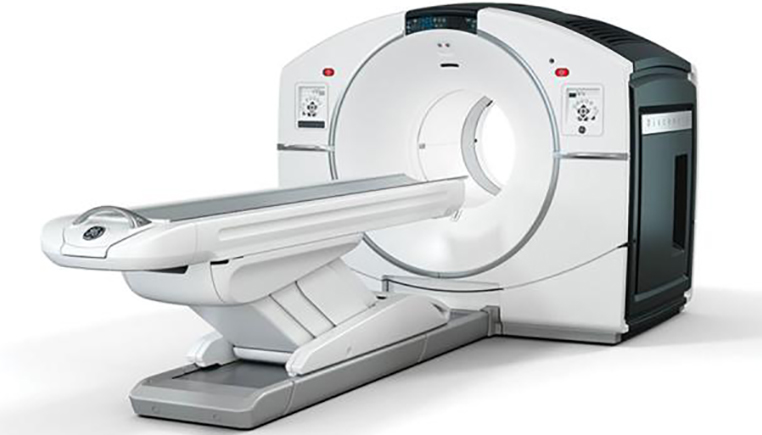There is no doubt that an institution like the University of the Free State (UFS), with its calibre and pedigree, needs a
PET/CT machine (medical-imaging device that simultaneously and clearly reveals both anatomical details and metabolic processes within the body), particular in oncology, in improving the management of patients.
Positron emission tomography (PET) is a type of nuclear medicine imaging modality that measures the metabolic activity of the cells of body tissues. PET imaging is useful in the evaluation of patients with neurological, cardiac, infection, inflammation, and most importantly oncological conditions. Through its ability to detect metabolic changes very early, it can detect disease conditions that might not be easily detected on other forms of anatomical imaging.
Role of PET/CT in different clinical scenarios
In his lecture, Prof Vangu talked about the role of PET/CT in different clinical scenarios. By giving practical examples, he explained the role of PET/CT in different aspects of clinical medicine, including brain imaging for dementia, movement disorder and cerebrovascular reserve.
“Looking at dementia, we will focus on one of diseases that is today becoming a major source of health concern, Alzheimer's disease. The latest Alzheimer's report that was published in 2018 stated that there are 50 million individuals currently suffering from Alzheimer's. They forecast that in 30 years we are going to have more than 150 million people suffering from this disease. PET/CT imaging can identify very early the typical patterns associated with all the different types of dementias, including Alzheimer's disease…”
For cardiac application, Prof Vangu said there are so many indications for PET/CT in cardiac imaging. One of the most important is the assessment of myocardial viability, in patients who have suffered from cardiomyopathy due to ischemic heart disease. PET/CT offers a noninvasive method of identifying viable myocardium that would benefit from revascularisation, with a very high diagnostic accuracy.
Prof Vangu, who is also the head of nuclear medicine at the Charlotte Maxeke Johannesburg Academic and Chris Hani Baragwanath hospitals as well as head of the department for radiation sciences at the University of the Witwatersrand, said PET has been around for many years and is not something new. However, in clinical practice, PET imaging became significant with a breakthrough that occurred with the production of the glucose analogue tracer, 18F-fluorodeoxyglucose (FDG). This tracer in PET/CT imaging has revolutionised the management of cancer patients for the oncologist. It offers the ability of more accurate cancer staging, assessment of treatment response, assessment of disease recurrence and in some situations, surveillance. It has the ability to predict early which cancer patients will benefit from a particular drug, thereby giving the oncologist an idea on either to de-escalate treatment or change to a second line regimen very early on in the management.

An internet example of an image taken by a PET/CT machine. Photo for illustration: A PET/CT Imaging machine.
PET/CT came onto the market only in the year 2001, when it was launched for the first time by David Townsend (a physicist) and Ronald Nutt (electrical engineer). As at today, almost every institution in the country has at least one PET/CT machine. “Looking at clinical applications, which is really the crux of the lecture today, there are so many clinical applications to talk about. You need a full week of a PET/CT symposium to go through all of them (and) maybe that might not even be enough. We can at least from this talk have an idea on how PET/CT can be applied in clinical medicine,” said Prof Vangu.
No other road for the university but to get a PET/CT machine
He also showed the impact and results that PET/CT imaging had in the management of infection and inflammation including TB. He said the role of PET/CT in TB is for monitoring of treatment, identification of extrapulmonary TB and prognosis.
In concluding his lecture, he said there is no other road for the university but to get a PET/CT machine. “There is no argument about it. The institution needs it to improve the management of patients, especially the oncology and cardiology patients. Confidently making the decision on which patients to treat, how to treat them, identifying and evaluating their true response to therapy requires a PET/CT machine.
“I am happy to hear that the policy- and decisions-makers in the province and the university are looking forward to having a PET/CT machine,” he said later.
Dr Osayande Evbuomwan, nuclear medicine specialist and Senior Lecturer, and
Dr Gerrit Engelbrecht, Clinical Head of the Department of Nuclear Medicine at the UFS, are both looking forward of having a PET/CT in the department because in addition to its use in clinical setting, it has a huge role to play in research and training postgraduate students, as PET/CT imaging makes up a huge chunk of the postgraduate training curriculum